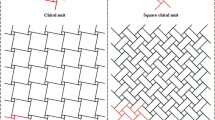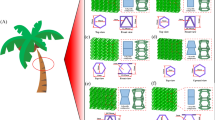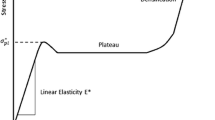Abstract
Flexible chiral honeycomb cores generally exhibit nonlinear elastic properties in response to large geometric deformation, which are suited for the design of morphing aerospace structures. However, owing to their complex structure, it is standard to replace the actual core structure with a homogenized core material presenting reasonably equivalent elastic properties in an effort to increase the speed and efficiency of analyzing the mechanical properties of chiral honeycomb sandwich structures. As such, a convenient and efficient method is required to evaluate the effective elastic properties of flexible chiral honeycomb cores under conditions of large deformation. The present work develops an analytical expression for the effective elastic modulus based on a deformable cantilever beam under large deformation. Firstly, Euler–Bernoulli beam theory and micropolar theory are used to analyze the deformation characteristics of chiral honeycombs, and to calculate the effective elastic modulus under small deformation. On that basis, the expression for the effective elastic modulus is improved by including the stretching deformation of the chiral honeycomb structure for a unit cell under conditions of large deformation. The effective elastic moduli calculated by the respective analytical expressions are compared with the results of finite element analysis. The results indicate that the analytical expression obtained under consideration of the geometric nonlinearity is more suitable than the linear expressions for flexible chiral honeycomb cores under conditions of high strain and low elastic modulus.








Similar content being viewed by others
References
Gibson LJ, Ashby MF (1997) Cellular solids: structure and properties, 2nd edn. Cambridge University Press, Cambridge
Heo H, Ju J, Kim DM (2013) Compliant cellular structures: application to a passive morphing airfoil. Compos Struct 106:560–569
Kuder IK, Arrieta AF, Raither WE, Ermanni P (2013) Variable stiffness material and structural concepts for morphing applications. Prog Aerosp Sci 63:33–55
Dale AS, Cooper JE, Mosquera A (2013) Topology optimization & experimental validation of 0-υ honeycomb for adaptive morphing wing. AIAA/ASME/AHS. Adapt Struct Conf 2007:67–70
McGowan AR, Cox DE, Lazos BS, Waszak MR, Raney DL, Siochi EJ, et al (2003) Biologically inspired technologies. In: NASA’s morphing project, proceedings of SPIE smart structures and materials conference, San Diego, CA, March, 2003, pp 1–13
Rodriguez AR (2007) Morphing aircraft technology survey. In: Proceedings of 45th AIAA aerospace sciences meeting and exhibit. Reno, NV, January, 2007 [AIAA Paper 2007-1258]
Lakes R (1987) Foam structures with a negative Poisson’s ratio. Science 235:1038–1040
Evans KE, Alderson A (2000) Auxetic materials: functional materials and structures from lateral thinking. Adv Mater 12:617–624
Bornengo D, Scarpa F, Remillat C (2005) Evaluation of hexagonal chiral structure for morphing airfoil concept. Proc Inst Mech Eng Part G J Aerosp Eng 219(2005):185–192
Spadoni A, Ruzzene M (2007) Static aeroelastic response of chiral-core airfoils. J Intell Mater Syst Struct 18:1067–1075
Olympio KR, Gandhi F (2010) Flexible skins for morphing aircraft using cellular Honeycomb cores. J Intell Mater Syst Struct 21:1719–1735
Olympio KR, Gandhi F (2010) Zero Poisson’s ratio cellular honeycombs for flex skins undergoing one-dimensional morphing. J Intell Mater Syst Struct 21:1737–1753
Gibson LJ, Ashby MF (1999) Cellular solids: structure and properties. Cambridge University Press, Cambridge
Kalamkarov AL, Saha GC, Georgiades AV (2007) General micromechanical modelling of smart composite shells with application to smart honeycomb sandwich structures. Compos Struct 38:1533–1546
Hohe J, Becker W (2000) A mechanical model for two-dimensional cellular sandwich cores with general geometry. Comput Mater Sci 19:108–115
Dai GM, Zhang WH (2009) Cell size effect analysis of the effective Young’s modulus of sandwich core. Comput Mater Sci 46:744–748
Hassani B (1996) A direct method to derive the boundary conditions of the homogenization equation for symmetric cells. Commun Numer Methods Eng 12(3):185–196
Gonella S, Ruzzene M (2008) Homogenization and equivalent in-plane properties of two dimensional periodic lattices. Int J Solids Struct 45:2897–2915
Reis FD, Ganghoffer JF (2012) Equivalent mechanical properties of auxetic lattices from discrete homogenization. Comput Mater Sci 51:314–321
Prall D, Lakes R (1996) Properties of a chiral honeycomb with a Poisson’s ratio of -1. Int J Mech Sci 39:305–314
Grima JN (2000) New auxetic materials. Ph.D. Thesis, University of Exeter, 2000
Alderson A, Alderson KL, Chirima G, Ravirala N, Zied KM (2010) The in-plane linear elastic constants and out-of-plane bending of 3-coordinated ligament and cylinder ligament honeycombs. Compos Sci Technol 70:1034–1041
Alderson A, Alderson K, Attard D, Evans K, Gatt R, Grima J, Miller W, Ravirala N, Smith C, Zied K (2010) Elastic constants of 3-, 4-and 6-connected chiral and anti-chiral honeycombs subject to uniaxial in-plane loading. Compos Sci Technol 70:1042–1048
Lorato A, Innocenti P, Scarpa F, Alderson A, Alderson K, Zied K, Ravirala N, Miller W, Smith C, Evans K (2010) The transverse elastic properties of chiral honeycombs. Compos Sci Technol 70:1057–1063
Reis FD, Ganghoffer JF (2012) Construction of micropolar continua from the asymptotic homogenization of beam lattices. Comput Struct 112–113:354–363
Eringen AC (1999) Microcontinuum field theories, vol I: foundations and solids. Springer, New York
Yoder M, Thompson L, Summers J (2018) Size effects in lattice structures and a comparison to micropolar elasticity. Int J Solids Struct 143:245–261
Duan SY, Wen WB, Fang DN (2018) A predictive micropolar continuum model for a novel three-dimensional chiral lattice with size effect and tension-twist coupling behavior. J Mech Phys Solids 121:23–46
Nady KE, Ganghoffer JF (2016) Computation of the effective mechanical response of biological networks accounting for large configuration changes. J Mech Behav Biomed 58:28–44
Liu XN, Huang GL, Hu GK (2012) Chiral effect in plane isotropic micropolar elasticity and its application to chiral lattices. J Mech Phys Solids 60:1907–1921
Spadoni A, Ruzzene M (2012) Elasto-static micropolar behavior of a chiral auxetic lattice. J Mech Phys Solids 60:156–171
Chen Y, Liu XN, Hu GK (2014) Micropolar modeling of planar orthotropic rectangular chiral lattices. C R Méc 342:273–283
Nady KE, Reis FD, Ganghoffer JF (2017) Computation of the homogenized nonlinear elastic response of 2D and 3D auxetic structures based on micropolar continuum models. Compos Struct 170:271–290
Bauchau OA, Craig JI (2009) Structural analysis: with applications to aerospace structures. Structural analysis with application to aerospace structures. Springer, Heidelberg
Nakamura S, Lakes RS (1995) Finite element analysis of Saint-Venant end effects in micropolar elastic solids. Eng Comput 12:571–587
Yang DU, Huang FY (2001) Analysis of Poisson’s ratio for a micropolar elastic rectangular plate using the finite element method. Eng Comput 18:1012–1030
Timoshenko SP, Gere JM (1961) Theory of elastic stability, 2nd edn. McGraw-Hill, New York
Banerjee A, Bhattacharya B, Mallik AK (2008) Large deflection of cantilever beams with geometric non-linearity: analytical and numerical approaches. Int J Non-Linear Mech 43(5):366–376
Acknowledgements
This study was funded by National Natural Science Foundation of China (Grant Numbers 11372250, 11772258).
Author information
Authors and Affiliations
Corresponding author
Ethics declarations
Conflict of interest
The authors declare that they have no conflict of interest.
Rights and permissions
About this article
Cite this article
Qiu, K., Wang, R., Wang, Z. et al. Effective elastic properties of flexible chiral honeycomb cores including geometrically nonlinear effects. Meccanica 53, 3661–3672 (2018). https://doi.org/10.1007/s11012-018-0911-6
Received:
Accepted:
Published:
Issue Date:
DOI: https://doi.org/10.1007/s11012-018-0911-6




